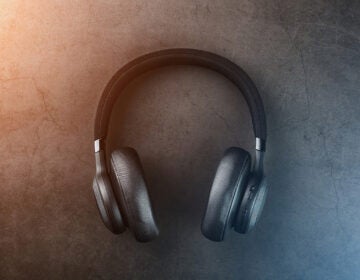Horror movie sounds evoke primal fear
Sound designers have a bag of acoustic “scares” to frighten and unnerve an audience.
Listen 7:14
(Illustration by Ella Trujillo)
It’s a dark and stormy night. Outside, the wind is howling. Rain is beginning to tap steadily at the window. You decide it’s the perfect setting to watch a scary movie. Armed with a bowl of popcorn, you dim the lights and settle in, ready to be spooked.
Like most good horror flicks, this one is a slow burn. There’s some tension in the beginning and a steady ramp up to the real action. Still, you find yourself tensing up early on, glancing over your shoulder more and more often.
Your ears begin to zero in on suspicious sounds around you — did a floorboard down the hall just squeak? What’s that? A tree branch rapping against the window? Some of this unease is manufactured — the film’s soundtrack has been designed to put you on edge.
“The ear in general has a far more direct line to your emotional response,” Kubilay Üner, a film composer and director of the music composition for the Screen Masters of Fine Arts program at Columbia College in Chicago.
He says in scary movies, the ear plays a big role in helping to manifest fear in a viewer.
“I think it has to do with the fact that it’s always on,” he says. “You can’t close your ears, and it’s the only thing that can look behind you.”
Üner says sound in film adds a dimension of emotion that’s difficult to achieve with visuals alone. Think about different kinds of scares you might experience as a viewer. The shrill, grating, metallic violins that paint the sonic picture of Norman Bates’ slashing blade in the movie “Psycho.” There’s the brooding, bellowing pulses of the orchestra forecasting the slow approach of the shark in ‘Jaws.’
One of the ear’s prime functions makes it a great tool for scaring people.
“We’re used to using our ears as alarm mechanisms,” Üner said.
All of the auditory elements that influence our emotional and physical reactions to scary movies are just like any other environmental stimuli — we encounter them and they evoke a biological response from our bodies.
Daniel Blumstein, who studies evolution and biology at the University of California in Los Angeles, has spent a lot of time thinking about how all that works.
His curiosity started after an encounter with a marmot — which is basically a big squirrel.
“I was holding a baby marmot and suddenly it screamed,” Blumstein said. “And I had this emotional response, and I wondered why I’m having an emotional response to a rodent screaming.”
This is what a screaming marmot sounds like, by the way:
Blumstein wondered if there could be a link between his visceral emotional response and the way people respond to certain types of music and film sounds.
He took the marmot scream and made a visual representation of it, called a spectrogram.
“And what was striking about marmot screams is that they illustrated things that bio acousticians call ‘nonlinearities,’” Blumstein said.
‘Nonlinearities’ are a lot of the jarring kinds of sounds you might hear when vocal cords or stereo speakers are overblown. Think chaotic sound noise, jarring whines, rapid and shrill shifts in frequency — the kinds of things that might make your ears perk up and your hair stand on end.
He found many of those elements are also present in sounds and music composers use them to score scary movies.
“I think the people that have been making films and music have implicitly known this,” Blumstein said. “What our work has shown is sort of the reason why — and this hypothesis links us to our ancestors — not just our human ancestors, but our nonhuman ancestors.”
WHYY is your source for fact-based, in-depth journalism and information. As a nonprofit organization, we rely on financial support from readers like you. Please give today.






